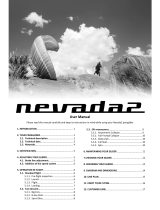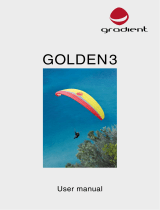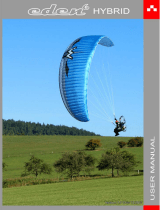Page is loading ...

EN
TONIC2
PRO
GUIDE

TONIC2 EN
TABLE OF CONTENT
1 Introduction 3
2 Description 4
3 Technical Data 5
4 Line System 5
5 Acceleration System 6
6 Flight Techniques and Characteristics 7
7 Descent Techniques 8
8 Materials 9
9 Homologation 10
10 Closing Words 11
11 Closing Words 12
12 Line Schematic 13
13 Line Length 13
14 Risers 14
15 Overview Glider 15
16 Test Protocoll 16
1 INTRODUCTION
Welcome to skywalk!
Congratulations on the purchase of your new TONIC2 and thank you for your trust in us
and in our products. In this manual you will find product-specific information that will help
you quickly get to know your new paraglider to ensure your fun for a long time.
General information about the most important safety-relevant points for handling your
paraglider can be found in the attached „BASIC GUIDE“.
We are always open for questions, comments or critique and are happy to provide you at
any time with further information!
Your skywalk Team
PURE PASSION FOR FLYING
Edition 3.1 / 11_2022
The latest version of the manual can be found on
www.skywalk.info
2 Table of content Introduction 3

TONIC2 EN
2 DESCRIPTION
The TONIC2 is the fun machine in our mini-wing range. The super-compact wing with
short span and short lines is aimed at those who like to soar in strong winds or close
to the slope. We like to call the TONIC2 the “go-kart” of the air because it converts
control impulses directly and precisely and loves high banking and dynamic turns.
Nevertheless, the field of application is surprisingly versatile - depending on the size
you choose.
PILOT REQUIREMENTS
Depending on the size and wing load, the TONIC2 sets different requirements to the pilot.
In the smallest size as well as in the extended weight ranges, the TONIC2 is classified as
LTF/EN C due to its high wing load. In this area the TONIC2 is suitable for pilots with reg-
ular flight practice who already have gained solid experience with others wings and pilots
who can handle a agile wing with high wing load.
The sizes S and M are classified to LTF/EN B in the standard weight range. In this range
the TONIC2 is also suitable for occasional pilots with less flight experience, as well as for
pilots who fly for the first time a wing with higher wing load and shorter lines.
SCOPE OF DELIVERY
The TONIC2 comes standard with inner bag, compression strap, riser bag
and “BASIC GUIDE”.
3 TECHNICAL DATA
Size
Cell number
Area flat (m²)
Wingspan flat (m)
Aspect ratio flat
Area projected (m²)
Wingspan projected (m)
Aspect ratio projected
min. profile depth (cm)
max. profile depth (cm)
Middle line length without risers (m)
Line consumption (m)
Weight (kg)
Take-off weight from - to (kg) for EN/LTF B
Extended weight range (kg) for EN/LTF C
Winch certified
JET FLAP Technology
Paramotor homologation
Accelerator
Maximum speed bar travel (mm)
Brake line travel max. (cm)
Trimmers
Number of seats
4 LINE SYSTEM
The layout of the suspension points is designed for optimal load distribution and a long
lifespan. With all considerations and calculations however, our focus is always on safety.
The mix of materials used on the lines of the TONIC2 is an ideal combination of durability,
low stretch and low drag.
The skywalk TONIC2 has 3 A-, 3 B-, 3 C-, and 1 stabilo line. The main-stabilo is connected
with the B-riser. The brake lines are not load-bearing and lead from the trailing edge over
the main brake lines through the brake pulleys on the C-risers to the brake handles.
A marking on the main brake line indicates the position of the handle attachment.
This setting should not be lengthened, for example, to provide more brake travel in extreme
flight situations or during landing, nor shortened such that the glider is flown constantly
with some brake on.
Technical data 5
4 Description
XS S M
33 33 33
16,30 18,70 21,10
8,40 9,00 9,60
4,33 4,33 4,33
14,00 16,00 18,10
6,75 7,24 7,69
3,27 3,27 3,27
95 102 109
237 254 269
5,29 5,67 6,02
226 243 259
‚ 2,4 2,6 2,8
– 50-85 65-105
50-95 86-105 106-120
yes yes yes
yes yes yes
no no no
yes yes yes
140 140 140
55 61 66
yes yes yes
1 1 1
* with Dyneema-riser. Weight with trimmer--riser approx. +250g

TONIC2 EN
To provide a better overview and to make sorting easier, the lines
have different colors:
> the AI, AII, AIII-lines and the A-risers are red.
> the BI, BII, BIII-lines and the B-risers are yellow
> the CI, CII, CIII-lines are blue.
> the stabilo lines are orange.
> the brake lines are orange.
The lines are attached with loops to oval shackles and secured with plastic inserts.
The skywalk TONIC2 has 3 risers per side:
> the A-lines lead to the A-riser
> the B-lines as well as the stabilo lines lead to the B-riser
> the C-lines lead to the C-riser
A schematic drawing of the risers can be found at the back of the manual.
5 ACCELERATION SYSTEM
The skywalk TONIC2 can be equipped with a foot-operated acceleration system.
The acceleration system affects the A and B-risers. Exact lengths of the accelerated
risers can be found at the end of the instruction. The riser is additionally equipped with
a trimmer. To activate the trimmer, a safety seam must be removed including the red
webbing. It is important to make sure that the trimmer webbing or other parts of the
riser are not damaged:
Proper removal of the seam above the safety material. (pic 1)
Wrong removal of the seam. Risk of damage to the trimmer webbing! (pic 2)
Please note:
Once the safety seam is removed, the loop on the trimmer webbing must be hooked into
the main carabiner. Only then the TONIC2 operates according to LTF/EN regulations.
6 FLIGHT TECHNIQUES AND CHARACTERISTICS
WINCHTOWING
The skywalk TONIC2 is well suited for winch towing. Make sure that you only use certified
winches and that you climb from the ground at a flat angle.
The pilot must have had proper towing instruction and must ensure that the winch
operator has had proper training that includes paragliders. When launching on a winch,
always fly with a lot of feeling and don’t brake too much as your glider will already have
an increased angle of attack. We recommend the use of a towing adapter.
FLYING WITH A MOTOR
Currently, the TONIC2 has no certification for flying with a motor. You can find out the cur-
rent status of motor certification at any dealer or importer, or by asking skywalk directly.
FULL STALL
To initiate a full stall, both brake lines must be pulled down symmetrically on both sides. The
glider will slow down steadily until the airflow over the top of the wing is interrupted. The
wing then suddenly will tilt backwards. Despite this unpleasant glider reaction, both brake
lines must be held down firmly until the glider has stabilized. The skywalk TONIC flies back-
wards in the full stall and usually forms a slight rosette at the front. To recover, guide both
brake lines symmetrically upwards (time> = 1 sec). The glider will open and surge forward to
pick up speed. Symmetrical braking prevents excessive forward surging of the wing. If the
pilot does not apply the brakes, the skywalk TONIC will surge forward, possibly leading to a
frontal collapse.
CAUTION
DUE TO THE HIGH SURFACE LOADING, WE DO NOT RECOMMEND FLYING
FULL STALL, SPIN OR PARACHUTAL STALL MANEUVERS WITH A TONIC2,
AS THESE CAN LEAD TO CHALLENGING GLIDER REACTIONS.
IN NO EVENT SHOULD THE BRAKES BE RELEASED WHILE THE STALLED
GLIDER IS STILL BEHIND THE PILOT. IF RECOVERY IS INITIATED TOO
EARLY, TOO FAST OR INCORRECTLY, THIS MAY, IN THE WORST CASE,
AUSE THE GLIDER TO SURGE FORWARD DANGEROUSLY.
You can find further information on practices and characteristics of flying in the en-
closed “BASIC GUIDE“.
6 Acceleration System Flight Techniques and Characteristics | Descent Techniques 7
1 2 3

TONIC2 EN
7 DESCENT TECHNIQUES
PULLING BIG EARS
In contrast to the spiral, your forward speed with »big ears« is higher than your
rate of descent. This rapid descent aid is used to quickly exit danger zones by flying
straight ahead in a desired direction.
The risk of collapses in turbulent air is significantly reduced with big ears. To perform
this maneuver, proceed as follows (according to DHV teaching instructions):
> Step on the speed bar half-way, grab the outer A-lines (AIII) above the line shackle
with your palms facing outward and pull the lines down.
> Now press the speed bar all the way. Keep the brake handles and the outer A-lines
in your hands during the maneuver.
> Check the symmetry of the collapsed glider.
> To recover, slowly release the A-lines. The glider usually will reinflate by itself.
> As soon as the glider is fully open, release the speed bar.
> To speed up reinflation, pull lightly on the brakes. Another proven technique
is to first reinflate one side of the glider, then then other. This can reduce the
risk of a stall.
Examples:
> If the pilot is surprised near a summit with little ground clearance by strong wind or a
thundercloud, neither a B-stall nor a spiral dive can help.
> If the pilot is stuck in very strong lift, it is advisable to exit the lift band with the use of
big ears and to find sinking air in which to lose altitude.
B-LINE STALL
The B-lines are pulled down symmetrically 10-15 cm. Keep the brake handles in the re-
spective hands. The airflow on top of the profile largely detaches and the paraglider de-
scends without flying forward. Pulling hard on the B-risers allows you to decrease the area
of the wing and increase your sink rate, but this also increases the risk of the wing form-
ing a rosette to the front. If this happens, recovery from the B-stall immediately!
You can exit the stall by quick and symmetric release of the B-lines. The paraglider will
pitch forward and pick up speed. At no time you may use the brakes in this case!
You can find further information about descent techniques in the enclosed “BASIC GUIDE”.
8 MATERIALS
The skywalk TONIC2 is manufactured from the highest quality materials. skywalk
has selected the best possible combination of materials with regard to resilience,
performance and longevity. We are aware that the durability of the glider is a deciding
factor in the pilot’s satisfaction.
WINGS AND RIBS
Upper sail: Porcher Skytex 38g / Dominico Dokdo 32g
Lower sail: Porcher Skytex 27g
Ribs: Porcher Skytex 27g hard
LINES
A, B, C Main lines: Liros PPSLS 180/125
A, B, C Middle lines: Liros PPSLS 125/65
A, B, C Top lines: Liros DC 60
Brake lines: Liros DFLP 200/32, PPSLS 65
RISERS
The risers are made of 12mm webbing. Stretching values, strength and stability
of this material is among the highest of all webbing products available.
The TONIC2 is also available with 6 mm Dyneema risers. The Dyneema risers do not
have trimmers.
9
8 Descent techniques | Materials

TONIC2 EN
9 HOMOLOGATION
The TONIC2 is certified to LTF II 91/09 and EN926-1, EN926-2 in the category B and C.
The TONIC2 is defined as a lightweight sport aircraft with an empty weight of less than
120kg in the paraglider category. The many homologation tests are the last hurdle in the
development of a skywalk paraglider. The homologation test flights only take place when
the test team is completely happy with the glider development.
We remark that the certification results will differ during flight in thermals or turbulent air.
The homologation informs solely regarding the paraglider performance during extreme-
flight- manoeuvres performed in stable air conditions. These extreme-flight-manoeu-
vres during the homologation process should thus not be over-valued.
Remember that certification maneuvers were carried out with a harness in the group GH
with a carabiner distance (middle to middle) of 42-46 cm. If another harness is used, the
glider may display flight characteristics that differ from those in the description.
10 CLOSING WORDS
The skywalk TONIC2 is at the pinnacle of paraglider development in the market for
mini-wings and shows what is possible regarding performance, safety and innovation.
It cost us a lot of time to develop this glider, but it was also a lot of fun. In this develop-
ment we recognize the challenge of making the right product for every area and individual
taste. We are pleased if you notice this during your first flight and if you feel a certain
unity with your glider from the very beginning.
The TONIC2 will provide you with plenty of joy over many years if you treat it and care
for it properly. Respect for the demands and dangers of our sport are essential for suc-
cessful and beautiful flights.
Even the safest paraglider can be dangerous due to misjudgments of meteorological
conditions or pilot error. Always remember that flying sports are potentially risky and that
you are responsible for your own safety. We advise you to fly carefully and to respect laws
in the interest of our sport, because every pilot always flies at his or her own risk!
WE WISH YOU A LOT OF FUN WITH YOUR NEW GLIDER AND ALWAYS
HAPPY LANDINGS!!
Your skywalk Team
Closing words 11
10 Homologation

TONIC2 EN
12 LINE SCHEMATIC
This line schematic is only for
illustration purposes.
11 LOOPS& HOOKS
The TONIC2 is equipped with “Loops & Hooks”.
These are used to secure the canopy in difficult terrain. Proceed as follows:
Connect the line of the hook with the loop on the canopy.
The loop is sewn on the upper sail about 20cm above the cell opening on rib 6.
13 LINE LENGTH
Total line length TONIC2 size: XS, S and M: www.skywalk.info
Single line length TONIC2 size: XS, S and M: www.skywalk.info
A (AIII, AII, AI) B (S, BI, BII, BIII) C (CIII, CII, CI)
brmain
BIII
BII
a2
a1
A1
A2
a4
a3
AI
AII
A4
A3
a6
a5
a8
a7
a12
a11
a10
a9
A6
A5
s1 s2
S1 S2 S3
s3
s5 s6 s7
s4
S
b3
b2
b1
b4
B2
B1
b7
b6
b5
b8
B4
B3
BI
AIII
b12
b11
b10
b9
B5
B6
c2
c1
d2
d1
d4
c5 d5
d3
C1
C2 c3
CI
c4
c7
c6
d7
d6
d9
c10 d10
d8
C3
C4 c8
C5
C6
c9
c11 d11
c12 d12
c13
c14
d13
d14
CII
CIII
br4
br3
br2
br1
br8
br7
br6
br5
BR3
BR2
BR1 brmain
BR4
BRI
BRII
Loopcover
Line schematic | Line length 13
12 Loops & Hooks
Encumber the hook or put it into the ground.
.

TONIC2 EN
14 RISERS
14 Risers Overview Glider 15
Trimspeed
1 Main lines
2 Top lines
3 Bottom sail
4 Cell openings
5 Top sail
6 Trailing edge
7 Nameplate
15 OVERVIEW GLIDER
420 mm
540 mm
A
360 mm
B
C
513 mm
540 mm
A
500 mm
B
C
Trimspeed Accelerated flight
405 mm
500 mm500 mm
360 mm
Trimmers open Trimmers open + Speedbar

TONIC2 EN
16 Test Protocol
TEST PROTOCOL Date:
Customer, Name:
Adress: Phone:
Glider: Size: Serial number:
Type certificate number: Date of last check:
Date of first flight: Year of construction:
Accomplished checking: Results [+/–]: Description of failure: Suggested repairs:
Identification:
Visual check of canopy:
Upper surface:
Lower surface:
Profiles:
Line flares:
Leading edge:
Trailing edge:
Crossports:
Visual check of lines:
Seams:
Abrasion spots:
Core withdrawals:
Visual check of connectionparts:
Suspension line screw locks:
Risers:
Length measurement:
Risers:
Lines:
Examinations of the canopy:
Firmness of canopy:
Porosity:
+
+
+
+
+
+
+
+
+
+
+
+
+
+
+
+
-
-
-
-
-
-
-
-
-
-
-
-
-
-
-
-
+-
16
Test Protocol 17
Examinations of the lines:
Firmness of main lines: daN
Results [+/–]: Description of failure: Suggested repairs:
Visual check of trimming:
Checkflight necessary?
Type certificate patch?
Identification plate?
Condition: New
Very good condition
Good condition
Well used
Heavily used, but within homologation standards, frequent checks required
No longer airworthy, outside of the limit values.
Repairs made?:
Signature of tester: Date:
Name of tester: Firm stamp:
+
+
+
+-
-
-
-

TONIC2
Skywalk GmbH & Co. KG
Windeckstr. 4 | 83250 Marquartstein
+49 (0) 8641/69 48 40
inf[email protected] | www.skywalk.info
/


